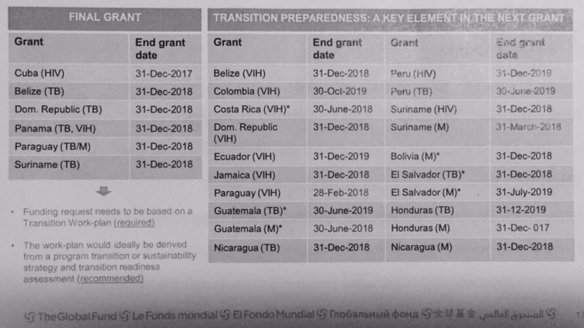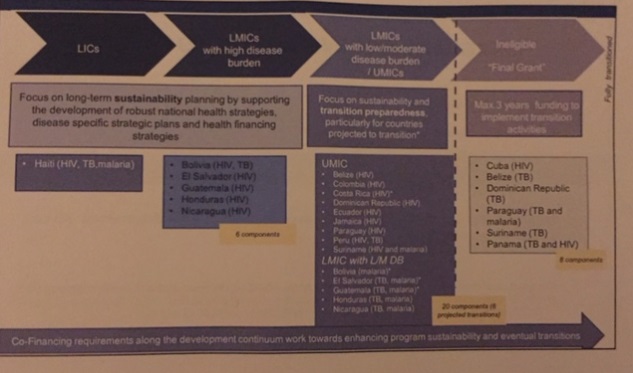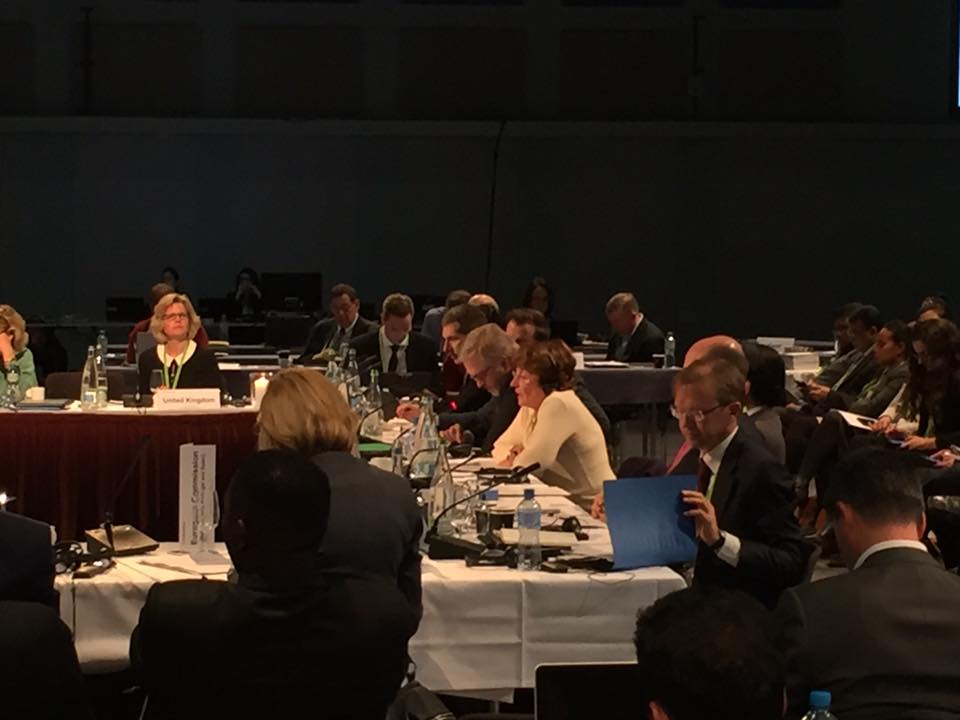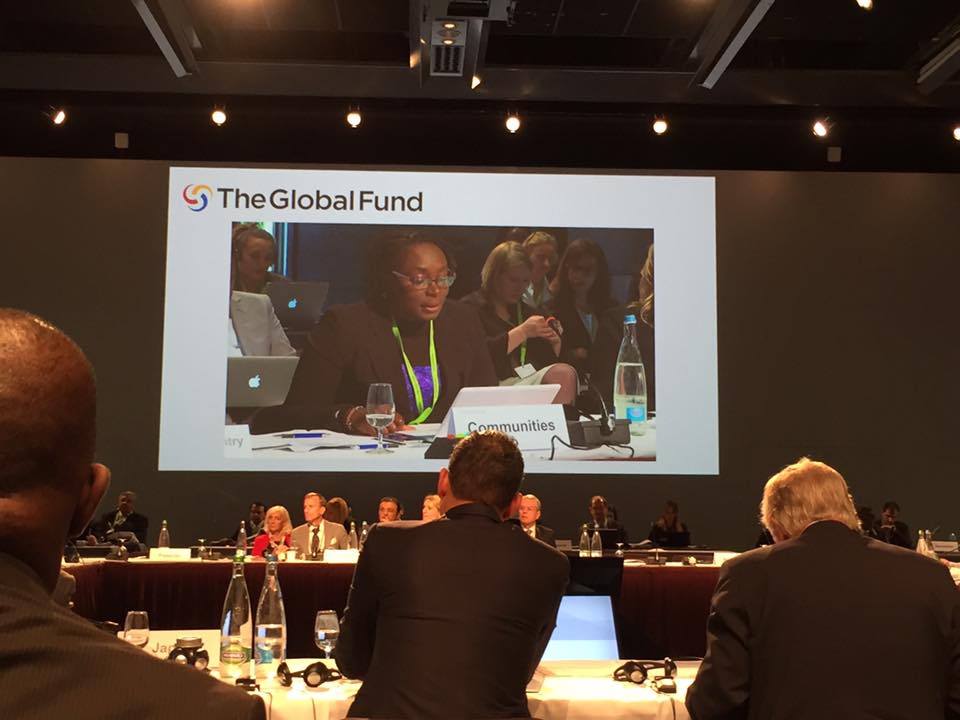Also available in: Español
Javier Hourcade Bellocq Corresponsales Clave
During the recent Global Fund meeting the situation in the next years for Latin America and the Caribbean was defined. The resource allocation policy was discussed which adds to other relevant policies recently approved. In this article find everything you need to know about the future of the Fund in our region.
On November 16 and 17, the 36th. Meeting of the Global Fund was held in the city of Montreux, Switzerland, under the somehow gray cloud of the electoral results in the United States, considering that it is the first financial contributor. Initiatives such as PEPFAR and an increase of the contribution to the Global Fund, took place in a republican government and they were strengthened during Obama’s administration. It is early to know whether the new administration, that soon will take the presidency of the United States, will mean a delay in the commitment of this country to the response to AIDS, tuberculosis and malaria worldwide. In the last Board meeting, the Sustainability, Transition and Co-funding (STC) policy was approved, which, somehow structured the process for the gradual withdrawal of the Global Fund from least priority countries, such as ours, this was a core topic in the meeting. After the “successful” replenishment of funds in Canada, now the allocation of such funds was discussed, among other less significant decisions.
What will happen in Latin America?

Table 1: Countries that should enter into a preparatory stage towards transition.
As we have reported in previous articles, Latin America, the Caribbean, Asia, East Europe and the Middle East, were no longer a priority for the Fund’s investment, due that reason and with a questionable formula of ranking middle and middle-upper income countries (per capita) with low epidemic burden. These arguments are questionable. The attempts to promote that dialogue started in 2006, at the first work group on eligibility and, today, ten years later, the priority reduction is already under way. We cannot complain, as the Global Fund has been the main donor in our region and in many countries we missed the opportunity to make a more significant difference in the response, involved in internal fights, micro-corruption and conflict of interests. Certainly there were moderate results, efficacy and efficiency, a debt from our governments and civil society; but anyway, this has not been the main reason for the Fund’s gradual withdrawal, the reason being merely of political nature. In the next years, depending on the stage of each grant, the Global Fund will be committed in its last funding rounds, that is to say that in 3,6, o 9 years, most of the programs in the fight against the three diseases shall continue only with their own resources.
Some important aspects. Here are some key aspects about the transition phase of the Global Fund from Latin America:
Table 2: Schedule for countries in this transition stage.

Managing the money remaining: The recipients of the Fund projects will not be able to use the surplus resources. Money that was not invested and spent by the date of the ongoing grant closing will not be used in an additional way for a new grant. It will then be deducted from the next allocation.
Quick access: Programs that will go from a funding cycle to the next one, with good performance and not planning significant changes, should not have to write a new and complete concept note, but a brief and updated version. The Global Fund will inform the CCM whether or not to submit (1) a program continuation, (2) tailored adjustments (which will be subject to partial review by the Technical Review Panel –TRP) or (3) a complete proposal with thorough review by the TRP. In all cases, countries must develop clear and specific plans on Sustainability, Transition and Co-funding (of our governments).
Eligibility: There have been no changes in the eligibility criteria, but there are countries that at macroeconomic and epidemiologic level have become less eligible. There will be more emphasis on the countries that still receive a financial allocation, to focus on high impact interventions, for instance, on key populations, as well as on sustainability and transition.
 Windows for presentations: During 2017, there will be 3 windows to submit proposals for those programs that have been invited to do so, and the deadlines are March 20, May 23 and August 28.
Windows for presentations: During 2017, there will be 3 windows to submit proposals for those programs that have been invited to do so, and the deadlines are March 20, May 23 and August 28.
List of countries: learning about which countries are still on the race and which ones will transition, has caused wakefulness to many regional colleagues. In table 1, we share such a list with some exceptions: Haiti is and will always be a priority and an eligible country for the three diseases. Along with Haiti, El Salvador, Guatemala, Honduras and Nicaragua must work in terms of sustainability while they will have more time to continue using the Fund resources to strengthen their health national systems and their responses. Cuba and Panama, in HIV, will only have a three-year round, focused on sustainability and transition. The remaining group will continue with its grants and might have access to a new three-year round, but in any case, they will have to focus already on sustainability and transition with a significantly lower resource allocation (in a lapse of time which is the addition of the current grant and the possibility of an additional three-year grant).
Schedule: Table 2 shows the schedule for completion of all grants, some of which, close to the date, will have the option to submit a final program focused on sustainability and transition.
A missed opportunity?
Latin America has been one of the best regions in implementing Global Fund programs, including some regional projects. Our governments, most of them, are still increasing their national investment in health and HIV, reason why the inevitable withdrawal of the Fund should not cost lives or quality loss in the programs. However, we used to think that the resources would flow forever, even when we had all the signs that it would not be like that. We wasted very precious time. The next years are fundamental to leverage the work and commitment in our countries, as afterwards we will be alone, at the “mercy” of our governments, their commitments and policies. The next three to six years are crucial to build a sustainable and resilient response in the Latin American countries. This may require for us to do things differently, better. It is a great (and the last one) opportunity for us, but we must work differently. There are not very auspicious symptoms. We face this regional fever, a new pandemic called sustainability and transition. It is the “(musical) hit of the summer” and would be generating some degree of satiety due to overexposure, which is serious, as in the next years the sustainability efforts will be fundamental to not lose the work achieved, meet the committed goals and end the epidemic. What happens is that we let ourselves be dragged to workshops and meetings that measure and do not deal with the underlying problem, which is that the response of civil society is not financially sustainable. “Sustainability, transition and co-funding” has become a marketing product and there are already half a dozen tools to measure the preparation of programs, civil society and the response for transitioning. The cause of this is that there is some money for this topic and a lot of opportunism.
It is absolutely obvious that what Paraguay needs is completely different from what Ecuador needs, and that the measurement tools, are not only general, superficial and imprecise, but they feed the naive fantasy that we are doing something, when we are only trying to measure, in the best case to diagnose. These days, during the Board meeting, we have heard a clear criticism from some technical partners about some contractor organizations and some civil society platforms of the special initiative on Community, Rights and Gender, on the poor performance and uncoordinated approach, particularly on the topic of STC. Squander in costly meetings, lush consulting contracts and repeated workshops for the same recipients, the same people, and same countries. It is neither the most reasonable nor responsible way to support the work on Sustainability and Transition. Much less sustainable will be those para-initiatives that try to position themselves without taking account of a diversity of networks and regional initiatives that already have a trajectory and established networks.
 The Board of the Fund will continue investing resources through special community initiatives, but not before submitting them to a deep evaluation. But this is a shared responsibility, we should reflect on what we are doing with the resources that we could use with more responsibility. In the coming weeks and months, we will have many key actors in the region discussing and planning a proactive and collaborative approach, with more responsibility in using the limited resources and the so much needed coordination. Let’s hope responsibility and common sense will prevail. We leave this last Board meeting with a moderate optimism that there is still room to take advantage of every minute and every cent and leave a strengthened, multisectoral and efficient response that may achieve the slogan of ending AIDS. The resources are in our countries, the issue is to put them at the service of this cause. There is clear commitment from the team of Latin America and the Caribbean at the Global Fund Secretariat, as well as in the delegation of the Board to support these processes in a coordinated manner.
The Board of the Fund will continue investing resources through special community initiatives, but not before submitting them to a deep evaluation. But this is a shared responsibility, we should reflect on what we are doing with the resources that we could use with more responsibility. In the coming weeks and months, we will have many key actors in the region discussing and planning a proactive and collaborative approach, with more responsibility in using the limited resources and the so much needed coordination. Let’s hope responsibility and common sense will prevail. We leave this last Board meeting with a moderate optimism that there is still room to take advantage of every minute and every cent and leave a strengthened, multisectoral and efficient response that may achieve the slogan of ending AIDS. The resources are in our countries, the issue is to put them at the service of this cause. There is clear commitment from the team of Latin America and the Caribbean at the Global Fund Secretariat, as well as in the delegation of the Board to support these processes in a coordinated manner.
